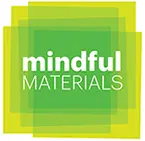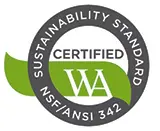Whenever possible, Wolf-Gordon seeks out third-party certifications to ensure that the products we distribute are objectively held to the highest sustainability standards.
Described as a “nutrition label for building projects,” Declare labels disclose all intentionally added and residual product ingredients at or above 100 parts per million (0.01%) that are present in the final product, by weight. Because each ingredient must be reported with a chemical name, CAS number, and percentage or percentage range, Declare labels enable specifiers to quickly and easily identify products that meet their project’s sustainability and human health requirements. A Declare label certifies that a product is Red List Free.

For more information about Declare, see the International Living Future Institute’s website.
The Intertek Clean Air Certification program is a 17065 accredited certification scheme that allows products to demonstrate that they meet applicable standards for low-emitting materials.
Clean Air GOLD Certification states conformance to ANSI/BIFMA e3-2019 standard credits 7.6.1, 7.6.2, and/or credit 7.6.3, which includes CDPH Standard Method v1.2 01350-2017 as well as conformance to low-emitting materials for WELL and LEED
The Living Building Challenge (LBC) is a set of criteria developed by the International Living Future Institute (ILFI) to promote a holistic and sustainable approach to building. The standard is iterative, and compliance is based on actual performance instead of modeling or expectations. For this reason, projects must be operational for a minimum of 12 consecutive months before evaluation.
The LBC applies to new buildings, as well as remodels of existing buildings that modify the building's envelope or major systems, interior projects, and landscape or infrastructure projects. The standard evaluates projects based on seven performance categories or "petals": place, water, energy, health and happiness, materials, equity, and beauty.
LBC guidelines include the Red List, which includes materials, chemicals, and elements that are known to be hazardous to human and ecosystem health. Products that do not contain materials on the Red List are certified with a Declare label.

The current Red List and other information about the Living Building Challenge can be found on the ILFI website.
mindful MATERIALS (mM) was developed in 2014 by building industry professionals (HKS) as an initiative that made transparency and optimization information easily accessible to designers as they select products. To qualify to be listed in the mindful MATERIALS database, a product must have an EPD, HPD, or meet low emission requirements. mindful Materials is the organization responsible for the creation of the Common Materials Framework.

Developed by the National Center for Sustainability Standards (NSF) in partnership with the Wallcovering Association, NSF/ANSI 342 is a sustainability assessment for wallcovering products. Stakeholders involved in developing this Standard included manufacturers, distributors, end-users, academics, state agencies responsible for environmentally preferable product procurement practices, and nongovernmental organizations. Its purpose is to communicate information that is verifiable, accurate, and not misleading about environmental and social aspects associated with the production and use of wallcoverings.
NSF/ANSI 342 is based on life-cycle assessment principles and employs an easy-to-use point system to evaluate wallcovering products against established requirements, performance criteria, and quantifiable metrics in six key areas:
Product Design
Product Manufacturing
Long-Term Value
End-of-Life Management
Corporate Governance
Innovation
Certification is based on point totals of the manufacturer and distributor, to achieve a Certified, Silver, Gold or Platinum level.

A USDA Certified Biobased product is third-party tested to verify its biobased content. The USDA establishes minimum biobased content standards for many product categories; a product must meet or exceed the minimum biobased content percentage in its given category in order to qualify for certification.